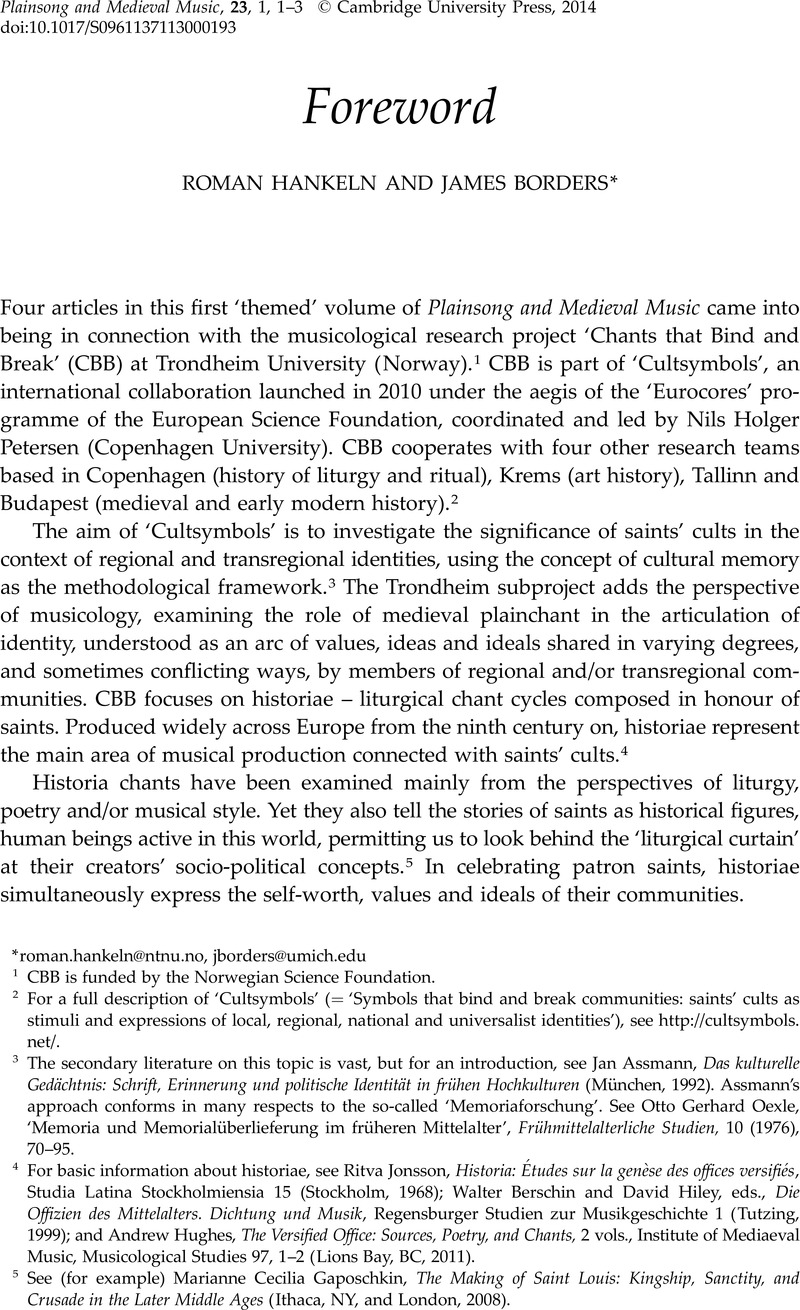No CrossRef data available.
Published online by Cambridge University Press: 26 February 2014

1 CBB is funded by the Norwegian Science Foundation.
2 For a full description of ‘Cultsymbols’ (=‘Symbols that bind and break communities: saints' cults as stimuli and expressions of local, regional, national and universalist identities’), see http://cultsymbols.net/.
3 The secondary literature on this topic is vast, but for an introduction, see Assmann, Jan, Das kulturelle Gedächtnis: Schrift, Erinnerung und politische Identität in frühen Hochkulturen (München, 1992)CrossRefGoogle Scholar. Assmann's approach conforms in many respects to the so-called ‘Memoriaforschung’. See , Otto Gerhard, ‘Memoria und Memorialüberlieferung im früheren Mittelalter’, Frühmittelalterliche Studien, 10 (1976), 70–95Google Scholar.
4 For basic information about historiae, see Jonsson, Ritva, Historia: Études sur la genèse des offices versifiés, Studia Latina Stockholmiensia 15 (Stockholm, 1968)Google Scholar; Berschin, Walter and Hiley, David, eds., Die Offizien des Mittelalters. Dichtung und Musik, Regensburger Studien zur Musikgeschichte 1 (Tutzing, 1999)Google Scholar; and Hughes, Andrew, The Versified Office: Sources, Poetry, and Chants, 2 vols., Institute of Mediaeval Music, Musicological Studies 97, 1–2 (Lions Bay, BC, 2011)Google Scholar.
5 See (for example) Gaposchkin, Marianne Cecilia, The Making of Saint Louis: Kingship, Sanctity, and Crusade in the Later Middle Ages (Ithaca, NY, and London, 2008)Google Scholar.
6 Jonsson, Ritva and Treitler, Leo, ‘Medieval Music and Language: A Reconsideration of the Relationship’, Studies in the History of Music, 1: Music and Language (New York, 1983), 1–23, at 22Google Scholar. Also see the discussion of older relevant literature in Hankeln, Roman, ‘St. Olav's Augustine-responsories: Contrafactum Technique and Political Message’, in Political Plainchant? Music, Text and Historical Context of Medieval Saints' Offices, ed. Hankeln, Roman, Institute of Mediaeval Music, Musicological Studies 111 (Ottawa, 2009), 171–99, particularly 179–81Google Scholar.
7 Exceptions include Björkvall, Gunilla and Haug, Andreas, ‘Text und Musik im Trinitätsoffizium Stephans von Lüttich. Beobachtungen und Überlegungen aus mittellateinischer und musikhistorischer Sicht’, in Die Offizien des Mittelalters: Dichtung und Musik, ed. Berschin, Walter and Hiley, David, Regensburger Studien zur Musikwissenschaft 1 (Tutzing 1999), 1–24Google Scholar; and Rankin, Susan, ‘Carolingian Music’, in Carolingian Culture: Emulation and Innovation, ed. McKitterick, Rosamond (Cambridge, 1994), 274–316Google Scholar.